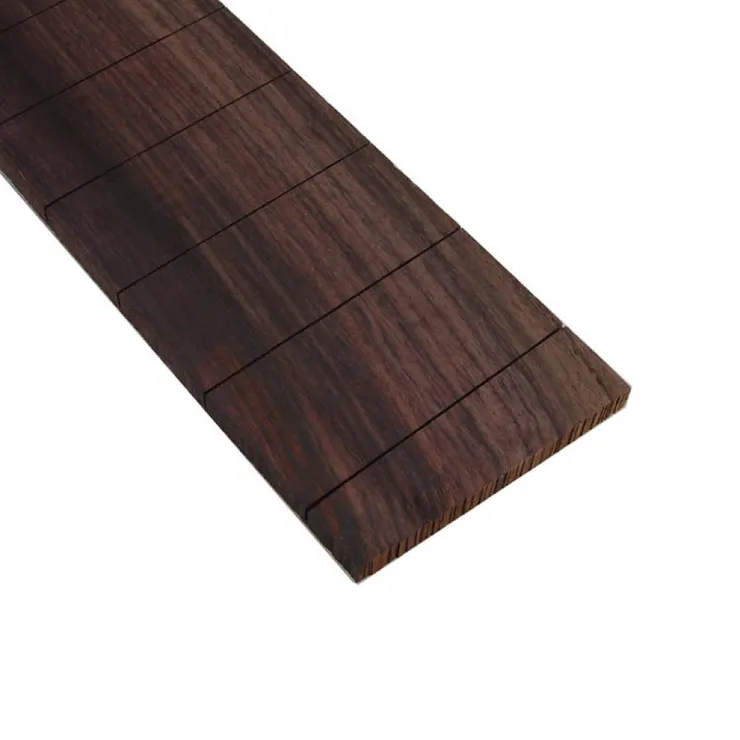As guitar technology and manufacturing processes evolve, so too do the materials used in guitar construction. One of the most significant developments in recent years has been the emergence of engineered fretboards, which can offer a range of benefits over traditional materials. But are engineered fretboards good, and do they live up to the hype? In this article, we’ll delve into the world of engineered fretboard materials and examine their impact on guitar tone, playability, and sustainability.
Traditional Fretboard Materials
Traditionally, guitar fretboards have been crafted from a small selection of tonewoods, notably ebony, rosewood, and maple. These materials have long been revered for their beauty, durability, and tonal properties and have been a feature of fretboard construction for centuries.
Ebony is a dense, dark-coloured wood with a smooth, tight grain. Guitarists cherish the wood for its bright, crisp tone and excellent sustain, making it a popular choice for acoustic and electric guitars. Conversely, rosewood is a slightly more porous wood with a rich, warm hue. Its tonal characteristics are darker and more resonant than ebony, and it’s particularly well-suited to fingerstyle playing. Maple is more akin to ebony, with a bright and snappy tone. Unlike ebony, however, it’s brighter in appearance and is the only tonewood of the three that needs to be finished with a coating to protect the wood.
Despite their many desirable qualities, however, ebony and rosewood have become increasingly scarce and expensive in recent years due in part to overharvesting and tightening trade restrictions. As a result, guitar builders have been forced to look for alternative materials to use in their instruments.
Engineered Fretboard Materials
Three of the most promising alternatives to traditional tonewoods are Richlite, Rocklite, and Micarta. These materials are all examples of engineered fretboards, created by bonding together layers of wood fibres or paper with resin under high heat and pressure. The result is a material that is extremely strong, durable, and resistant to moisture, making it an excellent choice for use in guitar fretboards.
Richlite is a composite material made from layers of phenolic-infused paper, which produce a smooth, hard surface that is both wear-resistant and easy to maintain. Rocklite, meanwhile, is a similar material composed of wood veneers and phenolic resins, designed to mimic the appearance and tonal characteristics of traditional tonewoods like ebony and rosewood. Finally, Micarta is a composite material made from layers of cloth, paper, or glass fibres, impregnated with resin and pressed together under high heat and pressure.
The Benefits of Engineered Guitar Fretboards
There are several advantages to using engineered materials in guitar fretboards, including their strength, durability, and resistance to moisture. Because these materials are created under high pressure and heat, they are less susceptible to warping, cracking, and other damage that can occur in natural wood over time. This durability makes them particularly well-suited to use as fretboards, which are subject to significant stress and tension from the strings.
In addition, engineered materials like Richlite, Rocklite, and Micarta are typically more consistent in grain structure, colour, and density than natural wood. This means they can be more easily and accurately machined, resulting in a smoother, more uniform fretboard surface. Some players also find that engineered materials offer a more comfortable playing experience, as their smooth, consistent texture allows for faster and more precise finger movements.
The Disadvantages of Manmade Fretboard Materials
Despite their many advantages, some potential downsides to using engineered materials in guitar fretboards exist. One of the most common concerns is that these materials lack the natural beauty and warmth of traditional tonewoods like ebony and rosewood. While some engineered materials, like Rocklite, are designed to mimic the appearance of natural wood, they can still lack the depth and character that many players find appealing.
Another potential drawback is the perception among some players that engineered materials have a negative impact on the tone and resonance of a guitar. It’s true that the density and composition of a fretboard material can influence an instrument’s overall sound. That said, it’s important to note that the impact of this factor is typically subtle. Variables such as the type of strings, pickups, and amplifiers used can easily overshadow any tonal contributions from the fretboard.
How do Engineered Fretboards Compare to Traditional Fretboards?
When comparing engineered fretboards to traditional materials, it’s essential to consider factors such as tone, playability, durability, and aesthetics. While it’s true that engineered materials may not offer the same level of natural beauty as ebony and rosewood, they provide several practical advantages, including increased strength, durability, and resistance to moisture.
In terms of tonal characteristics, engineered materials like Richlite and Rocklite produce a sound quite similar to traditional tonewoods, with a bright, clear tone and excellent sustain. However, some players may still prefer rosewood’s darker, more resonant sound or the crisp, bright attack of ebony.
Ultimately, the best fretboard material for you will depend on your personal preferences and playing style. If you value durability, consistency, and eco-friendliness over traditional aesthetics, then an engineered fretboard could be the perfect choice for you.
Which Guitar Brands Use Engineered Fretboards?
Several well-known guitar brands, including Gibson, Martin, and ESP, have embraced engineered fretboard materials in their instruments. These companies have recognised the many benefits of using materials like Richlite, Rocklite, and Micarta and have incorporated them into some of their designs to create high-quality, innovative guitars that cater to the needs of modern players.
For example, Gibson has used Richlite to construct several of its iconic Les Paul and SG models and its 2019 Sustainable Series guitars. Additionally, Martin has also utilised Richlite in its popular X Series guitars.
By using engineered fretboards in their designs, these guitar manufacturers can offer players a range of benefits, including increased durability, consistency, and sustainability, as well as a sound and feel comparable to traditional tonewoods.
The Sustainability of Engineered Fretboards
One of the most important factors to consider when evaluating the merits of engineered fretboards is their sustainability. With traditional tonewoods like ebony and rosewood becoming increasingly scarce, engineered materials made from recycled or renewable materials are clearly a more eco-friendly option.
In addition, the manufacturing process for engineered materials typically produces less waste and pollution than that of traditional tonewoods, further reducing their environmental impact. For players concerned about their instruments’ sustainability, an engineered fretboard could be the right choice.
Are Engineered Fretboards Good for Modern Guitar Innovation?
Are engineered fretboards good? As with many things in the guitar world, the answer is a resounding “It depends”! Traditional tonewoods like ebony and rosewood will always have their devotees who argue that alternative or manufactured materials simply don’t come close. But, to the modern or eco-conscious guitarist, engineered materials offer a range of benefits that make them a compelling choice. Whether you’re a professional musician or a hobbyist, an engineered fretboard may be just what you need to take your playing to the next level.
Find Your Engineered Fretboard Guitar
So, if you’re in the market for a new guitar and want to try an engineered fretboard for yourself, then isn’t it time you head over to our Finder tool? Select all your axe requirements and see just how easy we make finding the guitar of your dreams.

